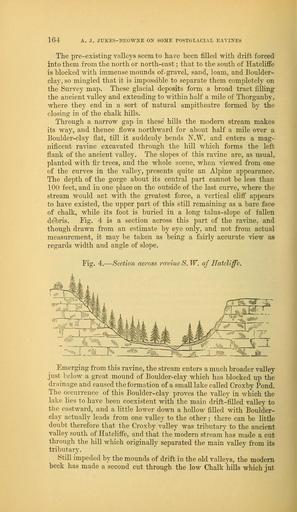MAKE A MEME
View Large Image

| View Original: | The_Quarterly_journal_of_the_Geological_Society_of_London_(14052672156).jpg (1204x2076) | |||
| Download: | Original | Medium | Small | Thumb |
| Courtesy of: | commons.wikimedia.org | More Like This | ||
| Keywords: The Quarterly journal of the Geological Society of London (14052672156).jpg 164 <br> A J JUKES-liROWIS E ON SOME POSTGLACIAL EAYINES <br> The pre-existing valleys seem to ha e been filled 'with drift forced <br> into them from the north or north-east ; that to the south of Hatcliffe <br> is blocked with immense mounds of- gravel sand loam and Bonlder- <br> clay so mingled that it is impossible to separate them completely on <br> the Survey map These glacial deposits form a broad tract filling <br> the ancient valley and extending to within half a mile of Thorganby <br> where they end in a sort of natural ampitheatre formed by the <br> closing in of the chalk hills <br> Through a narrow gap in these hills the modern stream makes <br> its way and thence flows northward for about half a mile over a <br> Boulder-clay flat till it suddenly bends JN' W and enters a mag- <br> nificent ravine excavated through the hill which forms the left <br> flank of the ancient valley The slopes of this ravine are as usual <br> planted with fir trees and the whole scene when viewed from one <br> of the curves in the valley presents quite an Alpine appearance <br> The depth of the gorge about its central part cannot be less than <br> 100 feet and in one place on the outside of the last curve where the <br> stream would act with the greatest force a vertical cliff appears <br> to have existed the upper part of this still remaining as a bare face <br> of chalk while its foot is buried in a long talus-slope of fallen <br> debris Tig 4 is a section across this part of the ravine and <br> though drawn from an estimate by eye only and not from actual <br> measurement it may be taken as being a fairly accurate view as <br> regards width and angle of slope <br> Fig 4 ” Section across ravine S W of Hatcliffe <br> Emerging from this ravine the stream enters a much broader valley <br> just below a great mound of Boulder-clay which has blocked up the <br> drainage and caused the formation of a small lake called Croxby Pond <br> The occurrence of this Boulder- clay proves the valley in which the <br> lake lies to have been coexistent with the main drift-fiUed valley to <br> the eastward and a little lower down a hollow filled with Boulder- <br> clay actually leads from one valley to the other ; there can be little <br> doubt therefore that the Croxby valley was tributary to the ancient <br> valley south of Hatcliffe and that the modern stream has made a cut <br> through the hill which originally separated the main vaUey from its <br> tributary <br> Still impeded by the mounds of drift in the old valleys the modern <br> beck has made a second cut through the low Chalk hills which jut 36940935 113697 51125 Page 164 Text 40 http //www biodiversitylibrary org/page/36940935 1884 Geological Society of London Biodiversity Heritage Library The Quarterly journal of the Geological Society of London v 40 1884 Geology Periodicals Smithsonian Libraries bhl page 36940935 dc identifier http //biodiversitylibrary org/page/36940935 smithsonian libraries Information field Flickr posted date ISOdate 2014-04-30 Check categories 2015 August 26 CC-BY-2 0 BioDivLibrary https //flickr com/photos/61021753 N02/14052672156 2015-08-26 05 51 25 cc-by-2 0 PD-old-70-1923 The Quarterly journal of the Geological Society of London 1884 Photos uploaded from Flickr by Fæ using a script | ||||